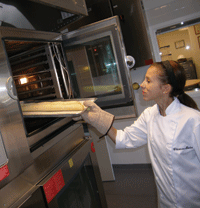Accelerated cooking technology has grown beyond heating sandwiches and novelty applications. In today’s fast-paced world, speed and efficiency are of the essence. The same could be said at foodservice operations where the bread and butter of the business depends on how fast the cooks can churn out consistent, quality food offerings.
That may be why accelerated-cooking technology is gaining ground so quickly. Once relegated to toasting sandwiches in QSR establishments, rapid-cook ovens, for example, are now finding their way into a variety of food-production venues, from catering and cafeteria operations to restaurants and hospital commissaries. As for induction, the clean, efficient cooking technology is no longer a novelty; it’s becoming an integral part of kitchen operations.
Shawn Jackson, chef at Mill Street Brew Pub in Ottawa, has been a believer in rapid-cook ovens since the restaurant opened in January 2012. His galley-style kitchen has four Merrychef Eikon e4 rapid-cook ovens. Two are at the pizza station, and used primarily for nachos; another two are used for sandwiches and finishing fish and some meats. Each is located on movable shelving units to allow for easy cleaning and maintenance; each costs $8,500. “We got them, because they produce a good product and allow us to get food out at a quicker rate. Our customers want quality food in a timely manner, because they don’t want to be here for long periods of time,” explains Jackson.
One big bonus is that the units are easy to program and understand, he adds. “It doesn’t take a lot of work to figure out what they do. And, with all the options, you can cook a variety of products, whether from scratch or just [for] finishing. We can use them for any protein, although I wouldn’t advise red meats; but they’re great for chicken and fish. I can’t imagine functioning without them.”
Even culinary program coordinators are ensuring their students learn about accelerated cooking. For example, Holland College in Charlottetown, is steadily increasing its inventory of rapid-cook ovens to meet industry demand, says Peter Crooks, executive director of Canada’s Smartest Kitchen (CSK), located at the college. “Rapid-cook oven technologies are really impacting the industry.”
Large-scale educational cafeteria operators are using more of these types of ovens to serve à la carte options. “If you walk into the sandwich or grill section that serves 1,000 people a day, you’ll probably see an impingement-type oven,” Crooks says.
Healthcare and extended-care operations are also becoming avid users of the technology, because they allow for quick-serve, smaller batch cooking. “That’s helpful for facilities having to do specialized cooking to meet dietary restrictions,” Crooks notes. “It’s a much healthier way to cook, because it uses less oil and reduces the risk of carcinogens from charbroiling.”
Accelerated cooking is becoming so popular that the major brands are implementing new features and functions to their rapid-cook oven lines in terms of footprint, programmable controls and versatility. “Whether it’s a Turbochef, Merrychef, Ovention, Duke or Amana, they’re all doing similar things in accelerated cooking,” says David Zabrowski, director of Engineering for PG&E Food Service Technology Center in San Ramon, Calif.
Manufacturers are also producing bigger lines. “Merrychef has half a dozen, Turbochef has eight or 10,” Zabrowski says. “It used to be one model and that was it.” The biggest selling point is that rapid-cook technology allows operators to add menu items without increasing their footprint in any significant way, Zabrowski notes. “Rapid-cook ovens can be a key element in the kitchen of the future. In one class, we did a full slate of foods using simply a fryer, combi-oven and rapid-cook oven.”
Turbochef and Ovention have also been making inroads into high velocity air-impingement conveyor ovens for batch- cooking applications. These are finding their place in the sandwiches and snack markets to replace panini grills or appetizer ovens. The one caveat with impingement conveyor ovens is that they’re designed to cook small amounts of food. “You can’t put one in an extremely busy takeout restaurant,” says Zabrowski.
But, when it comes to variations on accelerated cooking, induction is also impressing operators. Stefan Mueller, executive chef at the Delta Beausejour in Moncton, N.B., has been working with induction for more than a decade. These days, he has 12 permanent units and three portable ones from Mr. Induction (a brand from Chicago-based Sunpentown) and Iwatani (based in Fort Lee, N.J.).
“If you look at the energy costs, induction is the way to go, and there’s no residual heat to deal with. It’s also much cleaner and safer to work with than gas. Another plus is that [it doesn’t] require an exhaust hood, so portable units can be used in areas such as the pastry shop or in-room cooking,” Mueller explains.
The Delta chef is now looking to expand his induction repertoire to include woks and griddles. “Every time there’s a possibility for a kitchen renovation, I’m always considering induction. The only challenge is the costs. If you’re switching from electric, there’s a huge power savings in the long run. If it’s gas to induction, the price can be substantially higher,” adds Mueller.
“Induction is taking the market by storm,” confirms Holland College’s Crooks. “People were scared of it at first, but we’re putting in more and more induction burners at the school. The technology is fantastic, because it generates less heat, temperatures are more precise; you don’t need an evacuation system and you save energy.”
One key area where induction is becoming more popular is in catering, Crooks adds. “You can take 15 or 20 portable units to any site without having to transport fuel. That’s great for places that restrict open-flame cooking. You just plug it into an outlet and you’re ready to go,” he adds.
The only complication with induction is that it requires an investment in pots. While a growing number of pots are induction-compatible, chefs that have invested heavily in traditional aluminum-bottom equipment may have to swap old pots and pans for new, more suitable ones.
Michael Bryanton, research and development chef at Holland College’s CSK, says 90 per cent of the work done at the site is through induction. “We’ve always had it, because we like the heat control and efficiency. It’s especially useful in the summer when you’re working in a hot kitchen, because it keeps the heat down quite a bit.”
While induction can be expensive, if you are converting from gas, new restaurateurs are more likely than not to use induction. “If I was opening a restaurant right now, [I would have] induction cooking,” Bryanton states.
And, there’s at least one more reason operators should consider induction. Younger people are interested in working with it, Mueller says. “It’s a big draw from a hiring and retention point of view.” And, since labour and efficiency is a growing concern in the kitchen, rapid-cook and induction technology are viable options for success.





















